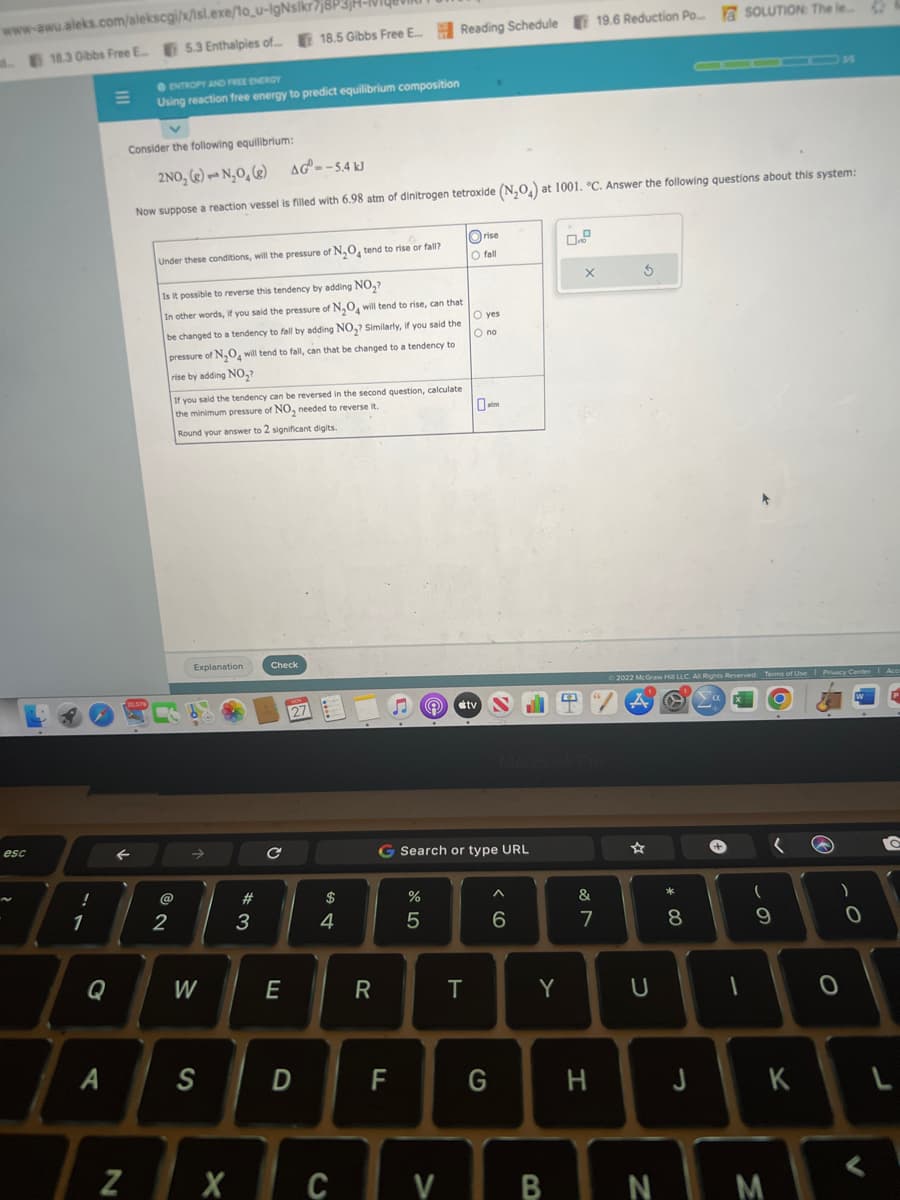Consider the following equilibrium: 2NO₂ (g) N₂O₂(g) AG=-5.4 kJ Now suppose a reaction vessel is filled with 6.98 atm of dinitrogen tetroxide (N₂O) at 1001. °C. Answer the following questions about this system: Under these conditions, will the pressure of N₂O tend to rise or fall? Is it possible to reverse this tendency by adding NO₂? In other words, if you said the pressure of N₂O₂ will tend to rise, can that be changed to a tendency to fall by adding NO₂? Similarly, if you said the pressure of N₂O will tend to fall, can that be changed to a tendency to rise by adding NO₂? If you said the tendency can be reversed in the second question, calculate the minimum pressure of NO, needed to reverse it. Round your answer to 2 significant digits. rise O fall O yes O no X
Consider the following equilibrium: 2NO₂ (g) N₂O₂(g) AG=-5.4 kJ Now suppose a reaction vessel is filled with 6.98 atm of dinitrogen tetroxide (N₂O) at 1001. °C. Answer the following questions about this system: Under these conditions, will the pressure of N₂O tend to rise or fall? Is it possible to reverse this tendency by adding NO₂? In other words, if you said the pressure of N₂O₂ will tend to rise, can that be changed to a tendency to fall by adding NO₂? Similarly, if you said the pressure of N₂O will tend to fall, can that be changed to a tendency to rise by adding NO₂? If you said the tendency can be reversed in the second question, calculate the minimum pressure of NO, needed to reverse it. Round your answer to 2 significant digits. rise O fall O yes O no X
Chemistry
10th Edition
ISBN:9781305957404
Author:Steven S. Zumdahl, Susan A. Zumdahl, Donald J. DeCoste
Publisher:Steven S. Zumdahl, Susan A. Zumdahl, Donald J. DeCoste
Chapter1: Chemical Foundations
Section: Chapter Questions
Problem 1RQ: Define and explain the differences between the following terms. a. law and theory b. theory and...
Related questions
Question

Transcribed Image Text:www-awu.aleks.com/alekscgi/x/isl.exe/1o_u-IgNsikr7j8P3,H-101
5.3 Enthalpies of....
esc
18.3 Gibbs Free E...
!
1
Q
A
←
N
ENTROPY AND FREE ENERGY
Using reaction free energy to predict equilibrium composition
Consider the following equilibrium:
2NO₂ (s)-N₂O₂(g)
AG=-5.4 kJ
Now suppose a reaction vessel is filled with 6.98 atm of dinitrogen tetroxide (N₂O4) at 1001. °C. Answer the following questions about this system:
Under these conditions, will the pressure of N₂O tend to rise or fall?
Is it possible to reverse this tendency by adding NO₂?
In other words, if you said the pressure of N₂O₂ will tend to rise, can that
be changed to a tendency to fall by adding NO₂? Similarly, if you said the
pressure of N₂O will tend to fall, can that be changed to a tendency to
rise by adding NO₂?
@
2
If you said the tendency can be reversed in the second question, calculate
the minimum pressure of NO₂ needed to reverse it.
Round your answer to 2 significant digits.
Explanation
W
S
#
3
Check
18.5 Gibbs Free E... Reading Schedule
Q
E
27
D
54
R
LL
F
G Search or type URL
%
5
Orise
O fall
Ⓡ stv
XC V
O yes
O no
T
G
^
6
Y
19.6 Reduction Po... SOLUTION: The le...
X
&
7
H
3
Ⓒ2022 McGraw Hill LLC. All Rights Reserved. Terms of Use | Privacy Center 1 Acc
U
* 00
8
J
a
(
9
BN M
K
(
)
0
V
P
C
L
Expert Solution
This question has been solved!
Explore an expertly crafted, step-by-step solution for a thorough understanding of key concepts.
This is a popular solution!
Trending now
This is a popular solution!
Step by step
Solved in 2 steps

Knowledge Booster
Learn more about
Need a deep-dive on the concept behind this application? Look no further. Learn more about this topic, chemistry and related others by exploring similar questions and additional content below.Recommended textbooks for you

Chemistry
Chemistry
ISBN:
9781305957404
Author:
Steven S. Zumdahl, Susan A. Zumdahl, Donald J. DeCoste
Publisher:
Cengage Learning

Chemistry
Chemistry
ISBN:
9781259911156
Author:
Raymond Chang Dr., Jason Overby Professor
Publisher:
McGraw-Hill Education

Principles of Instrumental Analysis
Chemistry
ISBN:
9781305577213
Author:
Douglas A. Skoog, F. James Holler, Stanley R. Crouch
Publisher:
Cengage Learning

Chemistry
Chemistry
ISBN:
9781305957404
Author:
Steven S. Zumdahl, Susan A. Zumdahl, Donald J. DeCoste
Publisher:
Cengage Learning

Chemistry
Chemistry
ISBN:
9781259911156
Author:
Raymond Chang Dr., Jason Overby Professor
Publisher:
McGraw-Hill Education

Principles of Instrumental Analysis
Chemistry
ISBN:
9781305577213
Author:
Douglas A. Skoog, F. James Holler, Stanley R. Crouch
Publisher:
Cengage Learning

Organic Chemistry
Chemistry
ISBN:
9780078021558
Author:
Janice Gorzynski Smith Dr.
Publisher:
McGraw-Hill Education

Chemistry: Principles and Reactions
Chemistry
ISBN:
9781305079373
Author:
William L. Masterton, Cecile N. Hurley
Publisher:
Cengage Learning

Elementary Principles of Chemical Processes, Bind…
Chemistry
ISBN:
9781118431221
Author:
Richard M. Felder, Ronald W. Rousseau, Lisa G. Bullard
Publisher:
WILEY